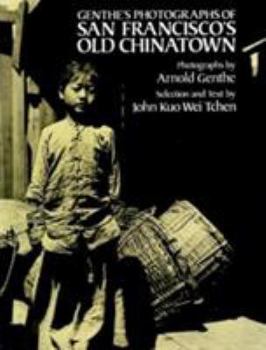Genthe's Photographs of San Francisco's Old Chinatown
Select Format
Select Condition 
Book Overview
In 1895, a cultured, well-educated young German named Arnold Genthe arrived in San Francisco as a tutor to the son of an aristocratic family. Almost immediately, Genthe was attracted by Chinatown, or... This description may be from another edition of this product.
Format:Paperback
Language:English
ISBN:0486245926
ISBN13:9780486245928
Release Date:October 1984
Publisher:Dover Publications
Length:144 Pages
Weight:0.98 lbs.
Dimensions:0.3" x 8.5" x 11.2"
Customer Reviews
1 rating
This is an excellent book
Published by Thriftbooks.com User , 25 years ago
Arnold Genthe was a German doctor of philosophy who arrived in San Francisco in 1895. He was fascinated by the Chinese and used his skill as an amatuer photographer to take over 200 photos of Chinatown's "Tangrenbu" section. These are valuable photographs as they depict Chinatown as it existed before the 1906 earthquake. Tangrenbu was the home of thousands of Chinese who were forced to live in this area due to de facto segregation and deep seated prejudice by San Franciscans. The Chinese were clannish and left few written records of their lives. The 1906 disaster destroyed whatever documents which may have existed so Genthe's pictures assume an importance beyond the mere fact of depicting persons and scenes. Chinese had been living in San Francisco as early as 1838, a full ten years before gold was discovered at Sutter's Mill. Between 1838 and 1849, Chinese were men of means, generally merchants, and few in number. As San Francisco boomed with gold seekers, the city experienced a continuing shortage of workers who were needed to lay roadways, reclaim swampy land, make boots and shoes, and to perform hundreds of other tasks. Native Americans wouldn't cooperate and Mexican-Americans were investing their time in gold mining.The solution was Chinese laborers as they had been used profitably on British colonial plantations in South America and the West Indies. Chinese merchants were employed as middlemen in the process of supplying the laborers. In a span of 30 years, hundreds of thousands of Chinese were lured onto British, American, and other western ships for the long trip across the Pacific Ocean. Conditions on these ships were often worse than on those of the African slave trade. The mortality rate ranged as high as 40%. During the 1850s and 1860s, 80% of the Chinese in California were spread throughout the mining areas. They were principally used in large company owned mines and had little hope of holding personal mining claims. They were disliked by most independent miners because of their race and their association with the large mining interests. The Chinese miners were also subject to the Foreign Miner's Tax. As primary contributors, they accounted for 50% of California's entire state revenues from 1850 to 1870.After the decline of mining, the building of railroads became the focus of merchant interests. Irish immigrants were hired by the Central Pacific (CP) to start construction near Sacramento but many refused the debilitating work of carving a few feet of granite daily from the Sierra Nevada mountain range. In 1865, the CP hired 50 Chinese laborers on a trial basis and told them to carve a road through the mountains.Pleased with the results, 10,000 Chinese were hired within 3 years and drove roadbeds through and over the mountain ranges. In the severe winter of 1866, Chinese crews worked and lived underneath the snow. Avalanches were frequent and buried many Chinese workers. Tw





